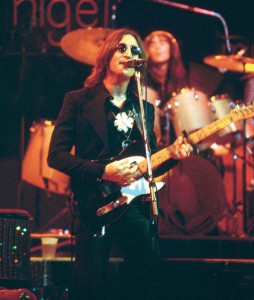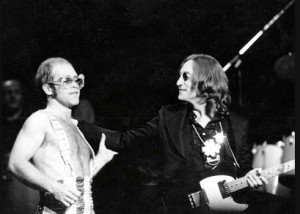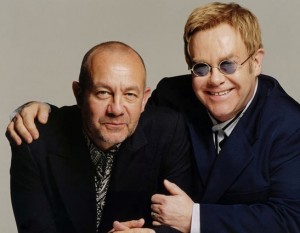 “Tiny Dancer” is the opening track of 1971’s “Madman Across the Water.” It’s one of those “backseat openers,” as I call them. I’d leave a department store — either P.T. or Weston’s or Hills, in what I once thought was the Big Town of Indiana, PA — with my parents, climb into the backseat of whatever big old Cadillac Daddy was driving at the time, take the record out of the bag, slice open the cellophane covering with my thumbnail, and pore over every word and image on the sleeve and vinyl disc during the 30-minute ride back to our small-town, four-room apartment.
“Tiny Dancer” is the opening track of 1971’s “Madman Across the Water.” It’s one of those “backseat openers,” as I call them. I’d leave a department store — either P.T. or Weston’s or Hills, in what I once thought was the Big Town of Indiana, PA — with my parents, climb into the backseat of whatever big old Cadillac Daddy was driving at the time, take the record out of the bag, slice open the cellophane covering with my thumbnail, and pore over every word and image on the sleeve and vinyl disc during the 30-minute ride back to our small-town, four-room apartment.
“Madman” was one of those albums that stayed on the platter of my cheap Sears Silverstone record player for weeks on end. I eventually digitized the LP — without applying Dolby (I wanted to hear the snap, crackle, pop) — so that I could listen to it in its original format on all my “devices.” Now, check out this vid. In fact, watch it two or three times. For me, it’s AGERTSAT – A Good Enough Reason to Stay Alive Today!
© Dana Spiardi, May 22, 2017
]]>
to measure record sales.
No song’s the winner,
no song ever fails.
Imagine all releases
treasured equally….
 Imagine the most defining song of John Lennon’s career NOT reaching the number one spot on the Billboard charts when it was released in October 1971. I wonder if you can. Surprisingly, John’s iconic peace anthem “Imagine” actually peaked at number three, which just goes to prove that chart position does not a legendary song make. John’s only solo career single to hit the number one spot during his lifetime was “Whatever Gets You Through the Night,” which topped the U.S. charts in November 1974.
Imagine the most defining song of John Lennon’s career NOT reaching the number one spot on the Billboard charts when it was released in October 1971. I wonder if you can. Surprisingly, John’s iconic peace anthem “Imagine” actually peaked at number three, which just goes to prove that chart position does not a legendary song make. John’s only solo career single to hit the number one spot during his lifetime was “Whatever Gets You Through the Night,” which topped the U.S. charts in November 1974.
As was his method, media junkie John often copped song titles and ideas from tabloids and boob tube babble. One late night, while channel surfing in his New York City apartment, he stumbled upon a program featuring the black evangelist Reverend Ike, who said unto the TV audience: “Let me tell you guys, it doesn’t matter, it’s whatever gets you through the night.” Bingo. The rest came naturally.
In the summer of 1974, John called on his friends – all top session players of the day – to seal the song on vinyl. They included guitarist Jesse Ed Davis and drummer Jim Keltner. John’s pal from the Beatles’ early Hamburg days, Klaus Voormann, played bass, and his British brother-in-therapy Elton John provided backing vocals and piano. But it’s the song’s blast of sax, provided by Texan shit-kicker Bobby Keys, that gave the tune its rollicking signature sound.
 Recorded for the “Walls and Bridges” LP, Lennon had little faith that the song would make an impact as a single. But Elton felt otherwise. He made a wager: if the song hit number one, John would have to promise to perform at Elton’s Thanksgiving concert at Madison Square Garden on November 28, 1974. On November 10, the song rocketed to number one in the U.S., and John made good on his promise. To the audience’s great surprise, a very nervous former Beatle took the stage with Elton to sing “Whatever Gets You Through the Night,” “Lucy in the Sky with Diamonds,” and “I Saw Her Standing There.”
Recorded for the “Walls and Bridges” LP, Lennon had little faith that the song would make an impact as a single. But Elton felt otherwise. He made a wager: if the song hit number one, John would have to promise to perform at Elton’s Thanksgiving concert at Madison Square Garden on November 28, 1974. On November 10, the song rocketed to number one in the U.S., and John made good on his promise. To the audience’s great surprise, a very nervous former Beatle took the stage with Elton to sing “Whatever Gets You Through the Night,” “Lucy in the Sky with Diamonds,” and “I Saw Her Standing There.”
Who would have ever imagined that it would be John’s final concert performance?
Out the blue or out of sight,
S’alright, John. S’alright.
Watch this fabulous video of the song. It’s comprised of animations of John’s whimsical drawings.
By Dana Spiardi, Oct 9, 2014
]]>
Bernie was no stranger to the slow, simple country life. He was born in a rural area in Lincolnshire, England – in a farmhouse that lacked electricity. Later, his father bought a run-down farm in the Lincolnshire village of Owmby-by-Spital. It was there that Bernie spent his days hitchhiking to dances, frequenting pubs and playing snooker. Boppin’ in the country, fishin’ in a stream — like the Honky Cat character he created.
His life changed forever in 1967 when he and Elton – unknown to one another – both answered a newspaper ad placed by a record label seeking new talent. Although neither artist passed the audition, Liberty Records’ A&R man Ray Williams put the two in contact, and they clicked. Bernie was 17 at the time. He’d end up following Elton down the yellow brick road to fame, but he’d never lose his memories of the family plow or the howling old owl in the woods.
 The two artists have collaborated on 30 albums through the years, but my favorites are the ones that evoke those idealized visions of an untamed, open-road America — the kind of place where we all picture ourselves rolling through the hay and running through the grass for hours. Your musical education won’t be complete until you’ve discovered the early gems — 11-17-70, Tumbleweed Connection, Madman Across the Water, and Honky Chateau – all released between 1970 and 1972. These works resonate with the beautiful sounds and images that formed everlasting grooves in my brain, many years ago.
The two artists have collaborated on 30 albums through the years, but my favorites are the ones that evoke those idealized visions of an untamed, open-road America — the kind of place where we all picture ourselves rolling through the hay and running through the grass for hours. Your musical education won’t be complete until you’ve discovered the early gems — 11-17-70, Tumbleweed Connection, Madman Across the Water, and Honky Chateau – all released between 1970 and 1972. These works resonate with the beautiful sounds and images that formed everlasting grooves in my brain, many years ago.
Here’s a real American beauty: “Amoreena” from “Tumbleweed Connection:” This song was used in the opening credits of the film “Dog Day Afternoon.” It’s interesting that a song about rural life would kick off a movie about a city crime caper.
“You’ll pick rotten peaches for the rest of your life.” This song about life on a chain gang is from “Madman Across the Water.” The album features two of Elton’s most enduring songs, “Tiny Dancer” and Levon.” Interestingly, “Madman” was the lowest-charting album of his career.
This is a live version of one of Elton and Bernie’s loveliest creations:
© Dana Spiardi, May 22, 2015
]]>